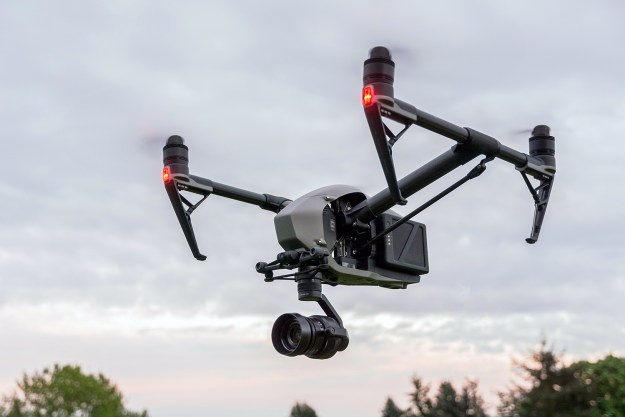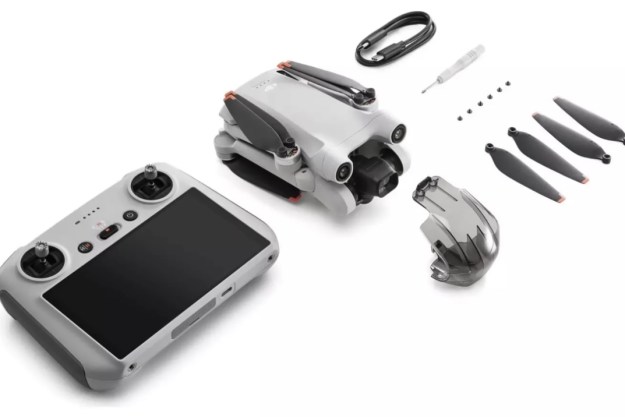
- Incredibly reliable
- Useful FPV camera
- Robust intelligent flight modes
- Plentiful accessories and upgrade options
- Expensive
- Not compatible with earlier Zenmuse cameras
When DJI released the original Inspire drone, it was an instant hit with filmmakers. Up until that point, if you wanted a drone that could carry a decent camera, you had to build it yourself — but then DJI came along, and suddenly anyone with $3,000 could get their hands on a pro-level 4K camera copter that was ready to fly straight out of the box.
Thing is, that was nearly three years ago. Drone technology has progressed in leaps and bounds since then, and nowadays you can get a 4K camera drone for under $500. But DJI isn’t one to be left behind. In late 2016, the company unveiled the second generation — and now that it’s out in the wild, we got our hands on one for an extended review.
Features and specs
A number of features make the Inspire 2 stand out from the rest of the pack, but generally speaking, it just has more stuff under the hood. We like to think that DJI calls it the Inspire 2 because it has two (or more) of everything.
Arguably the biggest inclusion is a dual battery setup, which gives the Inspire 2 a number of key benefits. Not only does it give the bird more flight time — it also protects it from battery malfunctions, and, more importantly, provides ample power for ancillary systems like cameras, stabilizers, sensors, and processors.
We like to think that DJI calls it the Inspire 2 because it has two (or more) of everything.
Speaking of cameras, not only does this drone rock a detachable and easily upgradable Zenmuse cam (ours came with the X5S), it also sports a forward-facing FPV camera, which allows the pilot to keep an eye on what’s ahead of the drone while simultaneously watching/controlling the Zenmuse camera.
It’s also equipped with dual inertial motion sensors, dual barometers, and dedicated processors for various subsystems — including the newly-added obstacle avoidance sensors. Hell, you can even fly it with two controllers. Together, these new additions serve to make the Inspire 2 far more reliable, stable, and safe to fly than any previous iteration.
Build quality and design
In terms of form, the Inspire 2 isn’t really a huge departure from the original model. It sports the same prop configuration, the same retractable landing gear system, and more or less the same body style. There are, however, a few small design upgrades that make the Inspire 2 more versatile and capable than its predecessors — despite the fact that it doesn’t look much different.
The most notable and noticeable design change is undoubtedly the Inspire’s new forward-facing FPV camera and obstacle-avoidance system. Both systems live in a nose-mounted sensor bar, which contains a small optical lens and two laser rangefinders. Aesthetically, it’s a fairly minor change — but in terms of functionality, these systems provide a huge benefit. Obstacle avoidance gives the drone the ability to autonomously prevent crashes, while the FPV camera allows the pilot (or pilots) to keep track of the Inspire’s heading, regardless of where the Zenmuse X5S might be facing.
Build quality is, as we’ve come to expect from DJI, off the charts. Even for a DJI drone, the Inspire 2 is ridiculously well built. The props feature a new locking system that ensures they’ll never come loose during flight, while the prop arms are made of the same super-strong carbon-fiber tubing that previous generations have. If this drone crashes (which is unlikely), the only components that’d likely suffer serious damage are the props and the camera. This thing is basically a flying tank.
Overall, the design is a victory. Instead of a massive overhaul, DJI took a winning formula and made a few small improvements — which we appreciate. It’s like trading in your car for a new model year: same look and feel, but with a few extra bells and whistles that make the driving experience completely different.
Battery life and recharge time
Battery life is hugely improved in the new Inspire. Whereas the original and Pro versions averaged about 15 minutes per charge, the Inspire 2 is rated for 27 minutes of flight time. In a simple hover test, we got just over 25 minutes of flight time before the drone went into emergency landing mode — but of course, that’s not really a good reflection of real-world use. During our normal flight tests, where we flew around and made use of the drone’s many subsystems, we averaged about 23 minutes of flight time. Like any other drone, if you use features that require more processing power (obstacle avoidance, Active Track, etc.), then you can expect to see a corresponding drop in flight longevity.
As for recharge time, you can expect about an hour on the charger before your battery reaches capacity. After our hover test (which ran the battery down to 10 percent and prompted DJI’s automated emergency landing sequence), the battery took about an hour and 20 minutes to charge up to 100 percent — but in most cases, you won’t be draining the batteries that much. If you do what most people do and land shortly after the first “low power warning” pops up, you’ll end up with roughly an hour on the power dock to recharge.
Hour-long recharge times aren’t particularly special — but one thing we do appreciate is DJI’s new charger dock. It’s designed to accommodate up to four batteries at once — and charge them all simultaneously. If your batteries are not paired, the hub will intelligently charge the cells according to power levels from high to low. If your batteries are paired, the pair with more stored power will charge first — which means you’ll get back into the air faster and spend less time waiting for your batteries to juice up.
Flight performance and autonomy
In the air, the Inspire 2 is a beast. It’s big, burly, outrageously stable, and more reliable than any drone we’ve ever flown. Despite the fact that it’s quite a bit heavier than its smaller brethren, the Phantom and Mavic Pro, it’s every bit as quick and nimble. Acceleration is a bit slower due to the bird’s extra weight and inertia — but once it gets up to speed, it leaves everything else in the proverbial dust.
The Inspire 2 far more reliable, stable, and safe to fly than any previous iteration.
DJI rates the Inspire 2 with a top speed of 58 miles per hour, but with a good tailwind you can easily get it up to 60 or higher. This is especially useful when you’re filming something that moves quickly — like a car, for example. We took it along for one of our car review video shoots (check out the video up top), and the drone didn’t have any trouble keeping pace as we zipped around corners and blasted down straightaways. That being said, if you need to use the Inspire’s obstacle avoidance abilities, you’ll be limited to a top speed of 45 miles per hour. Still, that’s pretty quick for sensor-aided flight.
Speaking of which, the Inspire boasts a slew of smart piloting features. In addition to DJI’s standard suite of Intelligent Flight modes (TapFly, Waypoint, Point of Interest, Active Track, etc), the Inspire 2 is also equipped with DJI’s new Spotlight Pro mode — which is immensely useful for filming moving objects.
Spotlight Pro uses DJI’s visual tracking algorithms to lock onto a subject during flight, regardless of the direction that the Inspire 2 flies — thereby enabling a single pilot to capture shots that would otherwise require a dedicated camera operator. If the gimbal comes close to reaching its rotation limits, the Inspire 2 itself will rotate in the same direction without affecting flight control –or the shot being captured– to free up gimbal movement. In other words, you can literally fly circles around a moving subject and the camera will stay trained on it regardless of how the drone rotates.
And that’s really just the beginning. Thanks to all the sensors and processing power packed into the Inspire 2, the drone can basically fly itself. That’s not just a figure of speech, either — it legitimately happened during our testing process.
During my first car-filming excursion, something went horribly wrong. Toward the end of the flight (which ultimately carried me about two miles away from the takeoff point), the Inspire’s battery levels hit 30 percent. Because the drone was still on its factory default settings, this caused the Inspire to initiate its “automatic return to home” function.
The drone can basically fly itself. That’s not just a figure of speech, either.
Normally, this wouldn’t be a problem – you can halt it with the flick of a switch in the app. But unfortunately I didn’t get that opportunity. At almost the exact moment that the Inspire stopped and turned to head back, my phone rang. The “you’re getting a call” screen popped up over the DJI Go app (Android | iOS), I panicked, and by the time I was done fumbling with my phone, the drone had already flown out of range — straight into a thicket of trees and wetland swamps.
For the first minute, I was in a state of sheer panic. I thought I had just lost a $6,000 drone, and was already dreading the call I’d have to make to DJI. But then I remembered that the Inspire 2 isn’t your average drone. It has advanced GPS, obstacle avoidance, and a slew of environmental sensors that all work in concert to make sure the drone doesn’t crash. So I crossed my fingers, hopped in the car, and headed back to the takeoff point.
Sure enough, the Inspire 2 was there. Somehow, it had managed to fly through a dense thicket of trees and foliage –completely unassisted, mind you– and navigate back to the exact point which it had taken off from. If that doesn’t inspire confidence in the drone’s autonomous flight capabilities, then I don’t know what will.
Camera and accessories
A stock Inspire 2 doesn’t actually come with a camera attached, but it’s designed to work with a handful of cameras in DJI’s Zenmuse line. Our review unit shipped with a top-of-the-line Zenmuse X5S: a Micro Four Thirds camera designed from the ground up to work with the Inspire 2.
In terms of capabilities, the X5S is big step up from its predecessors, the Zenmuse X4S and X5R. Most notably, it boasts a bigger sensor. With a pixel size of 3.4 microns, the 20.8 megapixel sensor can capture more detail than earlier generations, and also has better color sensitivity and a higher signal-to-noise ratio. As for resolution, it’s capable of shooting in 5.2K at 30 frames per second, 4K at 60 frames per second, and goes down as low as 720p.
You can also swap between one of 8 different lenses, ranging anywhere from 18mm to 90mm. This gives you more creative freedom and allows you to pick the lens that works best for the shot you’re trying to capture. Of course, you’ll have to pay extra for these lenses, since they aren’t included in the stock X5S package — but it’s still nice to have options.
Speaking of options, DJI also offers a range of awesome accessories for the camera system — such as a dedicated 480GB solid state drive designed specifically for storing the X5S’s footage, and a long-range focus control remote that gives you faster, more tactile control over the camera’s focus settings. So between the lenses, storage options, and specialized controllers; the Inspire 2 gives you a high degree of flexibility in how you film. Whether you’re an amateur or a pro, this platform has the gear you need to get the job done.
Update: Since the date this review was originally published, DJI has released the Zenmuse X7 camera — the first dedicated aerial camera from the company to use a large Super35 sensor, the standard format of professional cinema cameras from the likes of Arri, Red, Blackmagic Design, and Canon.
Our Take
The Inspire 2 is, without a doubt, one of the best drones we’ve ever had the pleasure of flying. The specs and features are top-tier — but what really makes this drone special is how reliable it is. Usually, flying a $3,000 drone with a $3,000 camera attached to it would be a nerve-wracking experience. That’s a lot of money hanging precariously in the air. But DJI has gone the extra mile with the Inspire 2 to ensure that it’s basically infallible — and that’s a big deal. It’s one thing to build a drone that can carry a nice camera, but it’s entirely another to build one that’s safe and stable enough that you can fly without getting sweaty palms. If you buy this drone, you aren’t just getting a high-end cinema quad; you’re also getting the peace of mind that comes from knowing your drone is safeguarded against malfunctions.
Are there better options available?
Despite being a great drone, the Inspire 2 occupies a weird middle ground between high-end consumer drones and ultra-expensive elite cinematography drones — so it’s not for everybody.
If you’re just an average Joe looking to capture some good-looking 4K video you can share on your YouTube channel, you probably don’t need an Inspire 2. DJI’s Phantom 4 Pro boasts all the same flying modes, has a camera with a slightly smaller image sensor in its camera, and costs less than a quarter (just $1,500) of what a fully-loaded Inspire 2 does. It’s definitely not as robust in its video capture abilities, but for the average user, the P4 Pro is simply a better value.
If you’re a pro filmmaker and want something even more powerful, you’d be wise to explore DJI’s Matrice 600 platform. It’s even beefier than the Inspire 2, and can carry state-of-the-art digital cinema cameras like the Red Epic and Hasselblad A5D. But of course, it’s also more expensive. The drone itself costs $5,000, and that’s not even counting the gimbal or the camera. A fully-loaded rig can cost upwards of $30,000.
If what you’re looking for is a “prosumer” drone like the Inspire 2, but with a lower price tag, you should check out the Tornado H920 from Yuneec. It’s a hexacopter, and boasts a similar suite of features and functionality, but only costs $4,000 with camera included. The drone’s specs aren’t quite as robust as DJI’s inspire, and Yuneec’s CGO4 camera is a bit of a step down from the Zenmuse X5S — but Yuneec’s package does offer more bang for your buck.
How long will it last?
Thanks to DJI’s upgradable design and high-end specs, the Inspire 2 will likely remain at the top of its class for years to come. Of course, it’ll eventually be dethroned by competitors and new DJI releases, but given the Inspire line’s slow release cycle and future-focused design, we’d bet that the Inspire 2 won’t become obsolete for at least another four or five years.
Should you buy it?
Yes. If you have $6,000 to spare and you’re after a professional aerial cinematography rig that’s ready-to-fly straight out of the box, the Inspire 2 and Zenmuse X5S should definitely be on your radar. If you are looking for deals, check out this awesome collection of the best Black Friday drone deals.
Editors' Recommendations
- The 3 best (reputable) DJI Drone alternatives in 2024
- DJI’s new Inspire 3 is an 8K drone for moviemakers
- Is DJI about to release a new drone?
- How to watch DJI unveil an all-new drone today
- The Insta360 Sphere is a virtual invisibility cloak for drones












